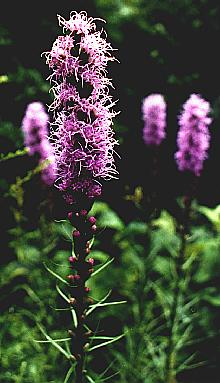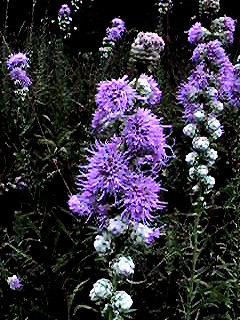Liatris spicata . . SPIKED GAYFEATHER

3 to 4 ft. . . Sun . . Avg. soil, well drained . . Native . . Bright rose-purple flowers arranged in tall dense spikes. Summer. Narrow leaves. The most commonly cultivated Liatris..
. . Zones 4 to 9 . . .
![]()

Blazing Star
Family: Composite
Size: 1 inch
Date: Late July
![]()
 Z
Z
Images and text copyright WILDSEED FARMS
Dense Blazing Star - Liatris spicata (Asteraceae)
An erect perennial native to the eastern United States extending as far south as Louisiana. The stiff, cylindrical spike is heavily concentrated with deep rose-purple flowers. The blooms begin to open from the terminal end of the spike and slowly descend toward the base. Prefers a moist, well-drained, fertile soil in full sun. Must be patient, may take two to three years to become established from seed.
Average planting success with this species: 50%
Height: 2-6 feet
Germination: 20-45 days
Optimum soil temperature for germination:
60-75F
Sowing depth: 1/8"
Blooming period: June-September
Average seeds per pound: 138,000
Seeding rate: 10 lbs. per acre
Suggested use: Accent along fence lines, cut
flower gardens.
Miscellaneous: The bulb of the plant can be transplanted for first year flowers. Has a vase life of 6 to 10 days. Excellent dried flower.
![]()
Liatris
"Spike Gay-feather"
Liatris spicata
L. pycnostachya (Kansas or cattail gay-feather), L. Spicata (spike gay-feather) (Also called blazing star) The tiny fuzzy blossoms of most gay-feathers usually begin to open at the top of the plants' 1 1/2-foot flower spikes rather than in the normal bottom-to-top sequence of the other plants. The Kansas gay-feather grows 4 to 6 feet tall and bears rosy lavender or white flowers in late summer and early fall. The spike gay-feather also boasts two fine varieties: the 18-inch 'Kobold', with deep rosy purple flowers, and 4-foot 'Floristan', with white blossoms; both bloom in mid- to late summer.
HOW TO GROW. Gay-feathers grow in Zones 3-10 in full sun or light shade. Soil must be well drained in winter in northern zones. Space plants 12 to 15 inches apart. Start new plants of named varieties by clump division in spring; others can be grown from seeds sown in spring to bloom the second year. To prevent overcrowding, divide clumps after three or four years of flowering.
![]()
![]()
Back to Plants
 Wildflower
Seed For Sale
Wildflower
Seed For Sale